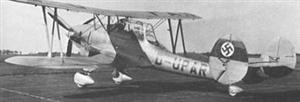Heinkel He-50 and Arado Ar-81 Dive Bombers
Heinkel He-50 Dive bomber
The Heinkel He-50, intended to be a dive bomber and reconnaissance aircraft, was designed in 1931 originally to meet an order from the Japanese navy. It had a crew of two, pilot and observer/rear gunner. A sturdy, two-bay biplane made of wood and metal, it had a span of 11.5 m (37 ft 9 in), a length of 9.6 m (31 ft 6 in), and an empty weight of 1,600 kg (3.528 lbs). Powered by one 650-hp Bramo 322B SAM 9-cylinder, air-cooled, radial engine, it had a speed of 235 km/h (146 mph), and a range of 600 km (373 miles).
Bramo was short for Brandenburgische Motorwerke (Brandenburg Engine Works). The He 50 was armed with one fixed 7.92-mm MG 17 machine gun firing forward, and one 7.92mm MG 15 machine gun aimed by the observer. A bomb load of 250 kg (551 lbs) was carried. Demonstrated to the Defense Ministry in 1932, the aircraft was adopted. In all, some 90 units were built, a few survivors seeing active service on the Eastern front as late as 1943.
Arado Ar-81 Dive Bomber
 First flown in the spring of 1936, the biplane dive bomber Arado Ar-81 had a crew of two, pilot and rear gunner. It had a length of 11.5 m (37 ft 9 in), a span of 11 m (36 ft), and an empty weight of 1,925 kg (4.244 lbs). Powered by one 640hp Junkers Motorenbau ( Jumo) 210Ca inverted-V, 12-cylinder, water-cooled engine, it had a speed of 344 km/h (214 mph), and a range of 692 km (430 miles). Carrying a bomb load of 250 kg (550 lbs) and armed with one fixed 7.92-mm MG 17 machine gun firing forward and one 7.92-mm MG 15 on flexible mounting in rear cockpit, the Ar 81 was superior in performance to the Junkers Ju 87, but the fact that it was a biplane made its production seem a retrograde step. So the “modern” monoplane Ju 87 was chosen, and the Ar 81 design was abandoned after three prototypes had been built.
First flown in the spring of 1936, the biplane dive bomber Arado Ar-81 had a crew of two, pilot and rear gunner. It had a length of 11.5 m (37 ft 9 in), a span of 11 m (36 ft), and an empty weight of 1,925 kg (4.244 lbs). Powered by one 640hp Junkers Motorenbau ( Jumo) 210Ca inverted-V, 12-cylinder, water-cooled engine, it had a speed of 344 km/h (214 mph), and a range of 692 km (430 miles). Carrying a bomb load of 250 kg (550 lbs) and armed with one fixed 7.92-mm MG 17 machine gun firing forward and one 7.92-mm MG 15 on flexible mounting in rear cockpit, the Ar 81 was superior in performance to the Junkers Ju 87, but the fact that it was a biplane made its production seem a retrograde step. So the “modern” monoplane Ju 87 was chosen, and the Ar 81 design was abandoned after three prototypes had been built.
